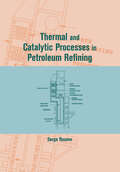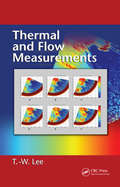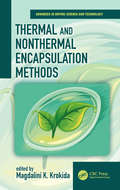- Table View
- List View
Thermal Safety of Chemical Processes: Risk Assessment and Process Design
by Francis StoesselCompletely revised and updated to reflect the current IUPAC standards, this second edition is enlarged by five new chapters dealing with the assessment of energy potential, physical unit operations, emergency pressure relief, the reliability of risk reducing measures, and process safety and process development. Clearly structured in four parts, the first provides a general introduction and presents the theoretical, methodological and experimental aspects of thermal risk assessment. Part II is devoted to desired reactions and techniques allowing reactions to be mastered on an industrial scale, while the third part deals with secondary reactions, their characterization, and techniques to avoid triggering them. Due to the inclusion of new content and restructuring measures, the technical aspects of risk reduction are highlighted in the new section that constitutes the final part. Each chapter begins with a case history illustrating the topic in question, presenting lessons learned from the incident. Numerous examples taken from industrial practice are analyzed, and each chapter concludes with a series of exercises or case studies, allowing readers to check their understanding of the subject matter. Finally, additional control questions have been added and solutions to the exercises and problems can now be found.
Thermal Sciences for Machines (Springer Tracts in Mechanical Engineering)
by Giorgio CornettiThis second volume of the textbook Hydraulic and Thermal Machines focuses on thermal machines. It covers the fundamentals of heat transfer and thermodynamics for reacting and non-reacting mixtures, and compressible fluids, followed by the principles of design, control and operation of thermal machines. With an uncomplicated yet rigorous approach, and using numerous examples, the book gradually guides readers through different kind of fluid machines/systems such as compressors, turbines, vapor and gas turbine power plants, internal combustion engines, and hybrid systems, discussing important issues for their application in propulsion. Furthermore, the book covers reversed cycle systems, with a special attention to air conditioning.
Thermal Sensors
by Chandra Mohan JhaThis book is a comprehensive guide to both the fundamentals of thermal sensors and their advanced functions. Key topics include sensor materials, CMOS-compatible sensors, measurement capabilities, thermal management and manufacturing processes. The introductory chapter covers the basic principles of thermal sensors from the essentials of heat transfer to smart wireless sensors. Later chapters illustrate the wide range of thermal sensor uses, from microprocessor thermal sensing to energy converter applications. Modeling and simulation techniques are used to explain the future direction of the field. Designed for researchers and practitioners working with wireless sensors and thermal management, Thermal Sensors: Principles and Applications for Semiconductor Industries is a valuable reference to the benefits and challenges these sensors offer. Advanced-level students studying mechanical or electrical engineering and networks will also find the content useful.
Thermal Separation Technology
by Matthias Kind Alfons Mersmann Johann StichlmairThermal Separation Technology is a key discipline for many industries and lays the engineering foundations for the sustainable and economic production of high-quality materials. This book provides fundamental knowledge on this field and may be used both in university teaching and in industrial research and development. Furthermore, it is intended to support professional engineers in their daily efforts to improve plant efficiency and reliability. Previous German editions of this book have gained widespread recognition. This first English edition will now make its content available to the international community of students and professionals. In the first chapters of the book the fundamentals of thermodynamics, heat and mass transfer, and multiphase flow are addressed. Further chapters examine in depth the different unit operations distillation and absorption, extraction, evaporation and condensation, crystallization, adsorption and chromatography, and drying, while the closing chapter provides valuable guidelines for a conceptual process development.
Thermal Spray Coatings: Fundamentals and Applications (Advanced Structured Materials #232)
by Santosh Kumar Chander Prakash Virat Khanna Swarn SinghThis book provides a comprehensive review of the effects of key factors ranging from powder characteristics to process parameters, substrate preparation, and post-treatment methods on the coated substrate surface by different thermal spray techniques. Thermal spray techniques have gained significant attention in various industries due to their ability to deposit protective coatings on substrates. These coatings enhance the surface properties of substrates, such as wear resistance, corrosion resistance, and thermal insulation. However, the quality and performance of the coated substrate surface are influenced by several key factors. The book discusses the influence of parameters such as powder characteristics, process parameters, substrate preparation, and post-treatment methods on the coating microstructure, adhesion, and overall performance. The review aims to contribute to a better understanding of the factors that affect the coated substrate surface and provide insights for future research and optimization of thermal spray processes.
Thermal Spray Fundamentals
by Pierre L. Fauchais Joachim V. R. Heberlein Maher I. BoulosThis book provides readers with the fundamentals necessary for understanding thermal spray technology. Coverage includes in-depth discussions of various thermal spray processes, feedstock materials, particle-jet interactions, and associated yet very critical topics: diagnostics, current and emerging applications, surface science, and pre and post-treatment. This book will serve as an invaluable resource as a textbook for graduate courses in the field and as an exhaustive reference for professionals involved in thermal spray technology.
Thermal Spreading and Contact Resistance: Fundamentals and Applications (Wiley-ASME Press Series)
by Yuri S. Muzychka M. Michael YovanovichThermal Spreading and Contact Resistance: Fundamentals and Applications Single source reference on how applying thermal spreading and contact resistance can solve problems across a variety of engineering fields Thermal Spreading and Contact Resistance: Fundamentals and Applications offers comprehensive coverage of the key information that engineers need to know to understand thermal spreading and contact resistance, including numerous predictive models for determining thermal spreading resistance and contact conductance of mechanical joints and interfaces, plus detailed examples throughout the book. Written by two of the leading experts in the field, Thermal Spreading and Contact Resistance: Fundamentals and Applications includes information on: Contact conductance, mass transfer, transport from super-hydrophobic surfaces, droplet/surface phase change problems, and tribology applications such as sliding surfaces and roller bearings Heat transfer in micro-devices and thermal spreaders, orthotropic systems, and multi-source applications for electronics thermal management applications Fundamental principles, thermal spreading in isotropic half-space regions, circular flux tubes and disc spreaders, and rectangular flux channels and compound spreaders Systems with non-uniform sink plane conductance, transient spreading resistance, and contact resistance between both non-conforming and conforming rough surfaces Providing comprehensive coverage of the subject, Thermal Spreading and Contact Resistance: Fundamentals and Applications is an essential resource for mechanical, aerospace, and chemical engineers working on research in the fields of heat transfer, thermal management of electronics, and tribology, as well as thermal engineers and researchers in the field of thermal physics.
Thermal Stability of Engineering Heterochain Thermoresistant Polymers
by Gennady Zaikov Kalugina GumargalievaThis book presents investigation results of thermal transformations in thermoresistant polymers: polysulfones, polyester-imides, aliphatic-aromatic polyimides and polyamides, liquid-crystal aromatic co-polyesters, polyphenylquinoxalines at temperatures of materials and articles processing and operation.An important result of investigations is the d
Thermal Stresses in Plates and Shells (Solid Mechanics and Its Applications #277)
by Mohammad Reza EslamiThis book covers thermal stresses in plates and shells, offering a cutting-edge exploration of this critical field. Tailored for a diverse audience, including graduate and postgraduate students, dedicated researchers, and scientists in both industrial and government sectors, as well as engineers specializing in mechanical, aerospace, and civil engineering. The book unfolds over eight meticulously crafted chapters, providing a detailed examination of thermal stresses in rectangular and circular plates, along with an array of shell geometries. Circular cylindrical, spherical, conical, and shells of revolution undergo rigorous analysis under various load conditions. A focal point of the text lies in the exhaustive treatment of tensor analysis within a curvilinear coordinate system. This framework lays the foundation for the derivation of precise strain-displacement relations for an array of shell configurations. The book further elucidates the transformation of Codazzi and Gauss conditions from surface continuity to compatibility conditions within elasticity theory. Chapter 5 introduces analytical solutions for diverse thermal loads affecting cylindrical, spherical, and conical shells. Chapters 6 and 7 delve into the intricate domain of coupled thermoelasticity, particularly in plates and shells subjected to shock loads. The book culminates in Chapter 8, where the intriguing phenomenon of thermal-induced vibrations in plates and shells takes center stage. With a commitment to accessibility, this self-contained volume presents mathematical concepts and numerical methods in an approachable manner, ensuring ease of comprehension for the reader. However, a foundational understanding of classical mathematics, mechanics, and elasticity theory is recommended for optimal engagement.
Thermal Stresses: Advanced Theory And Applications (Solid Mechanics And Its Applications Ser. #158)
by Naotake NodaThermal Stresses, 2nd Edition is the first book comprehensive volume on thermal stresses. It provides a sound grounding in the fundamental theory of thermal stresses as well as includes a multitude of applications. Many solved examples are included in the text, with numerous problems at the end of each chapter.The book starts with an introduction to the elementary theory, at the undergraduate level, and then progresses with the exposition of more advanced methods. The authors introduce the topics in a clear fashion, easy to grasp by students, engineers and scientists.
Thermal Stresses—Advanced Theory and Applications: Advanced Theory And Applications (Solid Mechanics and Its Applications #Vol. 158)
by M. Reza Eslami Richard B. HetnarskiThis is an advanced modern textbook on thermal stresses. It serves a wide range of readers, in particular, graduate and postgraduate students, scientists, researchers in various industrial and government institutes, and engineers working in mechanical, civil, and aerospace engineering. <P><P> This volume covers diverse areas of applied mathematics, continuum mechanics, stress analysis, and mechanical design. This work treats a number of topics not presented in other books on thermal stresses, for example: theory of coupled and generalized thermoelasticity, finite and boundary element method in generalized thermoelasticity, thermal stresses in functionally graded structures, and thermal expansions of piping systems. <P><P> The book starts from basic concepts and principles, and these are developed to more advanced levels as the text progresses. Nevertheless, some basic knowledge on the part of the reader is expected in classical mechanics, stress analysis, and mathematics, including vector and cartesian tensor analysis. <P><P> This 2nd enhanced edition includes a new chapter on Thermally Induced Vibrations. The method of stiffness is added to Chapter 7. The variational principle for the Green-Lindsay and Green-Naghdi models have been added to Chapter 2 and equations of motion and compatibility equations in spherical coordinates to Chapter 3. Additional problems at the end of chapters were added.
Thermal System Design and Optimization
by C. BalajiThis highly informative and carefully presented textbook introduces the general principles involved in system design and optimization as applicable to thermal systems, followed by the methods to accomplish them. It introduces contemporary techniques like Genetic Algorithms, Simulated Annealing, and Bayesian Inference in the context of optimization of thermal systems. There is a separate chapter devoted to inverse problems in thermal systems. It also contains sections on Integer Programming and Multi-Objective optimization. The linear programming chapter is fortified by a detailed presentation of the Simplex method. A major highlight of the textbook is the inclusion of workable MATLAB codes for examples of key algorithms discussed in the book. Examples in each chapter clarify the concepts and methods presented and end-of-chapter problems supplement the material presented and enhance the learning process.
Thermal System Optimization: A Population-Based Metaheuristic Approach
by Vimal J. Savsani Vivek K. Patel Mohamed A. TawhidThis book presents a wide-ranging review of the latest research and development directions in thermal systems optimization using population-based metaheuristic methods. It helps readers to identify the best methods for their own systems, providing details of mathematical models and algorithms suitable for implementation. To reduce mathematical complexity, the authors focus on optimization of individual components rather than taking on systems as a whole. They employ numerous case studies: heat exchangers; cooling towers; power generators; refrigeration systems; and others. The importance of these subsystems to real-world situations from internal combustion to air-conditioning is made clear. The thermal systems under discussion are analysed using various metaheuristic techniques, with comparative results for different systems. The inclusion of detailed MATLAB® codes in the text will assist readers—researchers, practitioners or students—to assess these techniques for different real-world systems. Thermal System Optimization is a useful tool for thermal design researchers and engineers in academia and industry, wishing to perform thermal system identification with properly optimized parameters. It will be of interest for researchers, practitioners and graduate students with backgrounds in mechanical, chemical and power engineering.
Thermal Systems Design: Fundamentals and Projects
by Richard J. MartinThermal Systems Design Discover a project-based approach to thermal systems design In the newly revised Second Edition of Thermal Systems Design: Fundamentals and Projects, accomplished engineer and educator Dr. Richard J. Martin offers senior undergraduate and graduate students an insightful exposure to real-world design projects. The author delivers a brief review of the laws of thermodynamics, fluid mechanics, heat transfer, and combustion before moving on to a more expansive discussion of how to apply these fundamentals to design common thermal systems like boilers, combustion turbines, heat pumps, and refrigeration systems. The book includes design prompts for 14 real-world projects, teaching students and readers how to approach tasks like preparing Process Flow Diagrams and computing the thermodynamic details necessary to describe the states designated therein. Readers will learn to size pipes, ducts, and major equipment and to prepare Piping and Instrumentation Diagrams that contain the instruments, valves, and control loops needed for automatic functioning of the system. The Second Edition offers an updated look at the pedagogy of conservation equations, new examples of fuel-rich combustion, and a new summary of techniques to mitigate against thermal expansion and shock. Readers will also enjoy: Thorough introductions to thermodynamics, fluid mechanics, and heat transfer, including topics like the thermodynamics of state, flow in porous media, and radiant exchange A broad exploration of combustion fundamentals, including pollutant formation and control, combustion safety, and simple tools for computing thermochemical equilibrium when product gases contain carbon monoxide and hydrogen Practical discussions of process flow diagrams, including intelligent CAD, equipment, process lines, valves and instruments, and non-engineering items In-depth examinations of advanced thermodynamics, including customized functions to compute thermodynamic properties of air, combustion products, water/steam, and ammonia right in the user’s Excel workbook Perfect for students and instructors in capstone design courses, Thermal Systems Design: Fundamentals and Projects is also a must-read resource for mechanical and chemical engineering practitioners who are seeking to extend their engineering know-how to a wide range of unfamiliar thermal systems.
Thermal Transport Characteristics of Phase Change Materials and Nanofluids (Emerging Materials and Technologies)
by S. Harikrishnan A.D. DhassThis book provides detailed information related to nanofluids, synthesis and preparation, morphologies of nanoparticles, selection of base fluids and thermophysical properties of nanofluids. The advantage of various conduits, the improvement of the heat transfer performance of phase change materials (PCMs), and the base PCMs for diverse applications are also discussed. Crucial difficulties like stability, aggregation, and clogging of nanoparticles are detailed including factors like the size, shape, and motion of nanoparticles that influence the heat transfer performance of nanofluids. Challenges, applications, and scope of the future works in the subject area are included. Features: Covers heat transfer techniques in utilization of base fluids application of phase change materials (PCMs) Describes preparation and characterization of nanofluids and nano-based PCMs Explains how nanoscience can be utilized in heat transfer studies Reviews conventional heat transfer fluids This volume is aimed at graduate students and researchers in thermal engineering, heat transfer, material science and engineering, and heat transfer enhancement.
Thermal Transport in Low Dimensions
by Stefano LepriUnderstandingnon-equilibrium properties of classical and quantum many-particle systems is oneof the goals of contemporary statistical mechanics. Besides its own interestfor the theoretical foundations of irreversible thermodynamics(e. g. of the Fourier's law of heat conduction), this topic is also relevant to developinnovative ideas for nanoscale thermal management with possible future applicationsto nanotechnologies and effective energetic resources. The first part of thevolume (Chapters 1-6) describes the basic models, the phenomenology and thevarious theoretical approaches to understand heat transport in low-dimensionallattices (1D e 2D). The methods described will include equilibrium and nonequilibriummolecular dynamics simulations, hydrodynamic and kinetic approaches and thesolution of stochastic models. The second part(Chapters 7-10) deals with applications to nano and microscale heat transfer,as for instance phononic transport in carbon-based nanomaterials, including theprominent case of nanotubes and graphene. Possible future developments onheat flow control and thermoelectric energy conversion will be outlined. This volume aims atbeing the first step for graduate students and researchers entering the fieldas well as a reference for the community of scientists that, from differentbackgrounds (theoretical physics, mathematics, material sciences andengineering), has grown in the recent years around those themes.
Thermal Transport in Oblique Finned Micro/Minichannels
by Poh Seng Lee Yan Fan Pawan Kumar Singh Yong Jiun LeeThe main aim of this book is to introduce and give an overview of a novel, easy, and highly effective heat transfer augmentation technique for single-phase micro/minichannel heat sink. The specific objectives of the volume are to: Introduce a novel planar oblique fin microchannel and cylindrical oblique fin minichannel heat sink design using passive heat transfer enhancement techniques Investigate the thermal transport in both planar and cylindrical oblique fin structures through numerical simulation and systematic experimental studies. Evaluate the feasibility of employing the proposed solution in cooling non-uniform heat fluxes and hotspot suppression Conduct the similarity analysis and parametric study to obtain empirical correlations to evaluate the total heat transfer rate of the oblique fin heat sink Investigate the flow mechanism and optimize the dimensions of cylindrical oblique fin heat sink Investigate the influence of edge effect on flow and temperature uniformity in these oblique fin channels.
Thermal Transport in Semiconductors: First Principles and Phonon Hydrodynamics (Springer Theses)
by Pol Torres AlvarezStarting from a broad overview of heat transport based on the Boltzmann Transport Equation, this book presents a comprehensive analysis of heat transport in bulk and nanomaterials based on a kinetic-collective model (KCM). This has become key to understanding the field of thermal transport in semiconductors, and represents an important stride. The book describes how heat transport becomes hydrodynamic at the nanoscale, propagating very much like a viscous fluid and manifesting vorticity and friction-like behavior. It introduces a generalization of Fourier’s law including a hydrodynamic term based on collective behavior in the phonon ensemble. This approach makes it possible to describe in a unifying way recent experiments that had to resort to unphysical assumptions in order to uphold the validity of Fourier’s law, demonstrating that hydrodynamic heat transport is a pervasive type of behavior in semiconductors at reduced scales.
Thermal Transport in Strongly Correlated Rare-Earth Intermetallic Compounds
by Heike PfauThis thesis explores thermal transport in selected rare-earth-based intermetallic compounds to answer questions of great current interest. It also sheds light on the interplay of Kondo physics and Fermi surface changes. By performing thermal conductivity and electrical resistivity measurements at temperatures as low as 25mK, the author demonstrates that the Wiedemann-Franz law, a cornerstone of metal physics, is violated at precisely the magnetic-field-induced quantum critical point of the heavy-fermion metal YbRh2Si2. This first-ever observation of a violation has dramatic consequences, as it implies a breakdown of the quasiparticle picture. Utilizing an innovative technique to measure low-temperature thermal transport isothermally as a function of the magnetic field, the thesis interprets specific, partly newly discovered, high-field transitions in CeRu2Si2 and YbRh2Si2 as Lifshitz transitions related to a change in the Fermi surface. Lastly, by applying this new technique to thermal conductivity measurements of the skutterudite superconductor LaPt4Ge12, the thesis proves that the system is a conventional superconductor with a single energy gap. Thus, it refutes the widespread speculations about unconventional Cooper pairing in this material.
Thermal analysis of Micro, Nano- and Non-Crystalline Materials
by Jaroslav Šesták Peter SimonThermal Analysis of Micro-, Nano- and Non-Crystalline Materials: Transformation, Crystallization, Kinetics, and Thermodynamics complements and adds to volume 8 Glassy, Amorphous and Nano-Crystalline Materials by providing a coherent and authoritative overview of cutting-edge themes in this field. In particular, the book focuses on reaction thermodynamics and kinetics applied to solid-state chemistry and thermal physics of various states of materials. Written by an international array of distinguished academics, the book deals with fundamental and historical aspects of phenomenological kinetics, equilibrium background of processes, crystal defects, non-stoichiometry and nano-crystallinity, reduced glass-transition temperatures and glass-forming coefficients, determination of the glass transition by DSC, the role of heat transfer and phase transition in DTA experiments, explanation of DTA/DSC methods used for the estimation of crystal nucleation, structural relaxation and viscosity behaviour in glass and associated relaxation kinetics, influence of preliminary nucleation and coupled phenomenological kinetics, nucleation on both the strongly curved surfaces and nano-particles, crystallization of glassy and amorphous materials including oxides, chalcogenides and metals, non-parametric and fractal description of kinetics, disorder and dimensionality in nano-crystalline diamond, thermal analysis of waste glass batches, amorphous inorganic polysialates and bioactivity of hydroxyl groups as well as reaction kinetics and unconventional glass formability of oxide superconductors. Thermal Analysis of Micro-, Nano- and Non-Crystalline Materials: Transformation, Crystallization, Kinetics, and Thermodynamics is a valuable resource to advanced undergraduates, postgraduates, and researches working in the application fields of material thermodynamics, thermal analysis, thermophysical measurements, and calorimetry.
Thermal and Catalytic Processes in Petroleum Refining
by Serge RaseevThis text examines the thermal and catalytic processes involved in the refining of petroleum including visbreaking, coking, pyrolysis, catalytic cracking, oligomerization, alkylation, hydrofining, hydroisomerization, hydrocracking, and catalytic reforming. It analyzes the thermodynamics, reaction mechanisms, and kinetics of each process, as well as
Thermal and Catalytic Processing in Petroleum Refining Operations (Petroleum Refining Technology Series)
by James G. SpeightThis book presents the thermal and catalytic processes in refining. The differences between each type of process and the types of feedstock that can be used for the processes are presented. Relevant process data is provided, and process operations are fully described. This accessible guide is written for managers, professionals, and technicians as well as graduate students transitioning into the refining industry. Key Features: Describes feedstock evaluation and the effects of elemental, chemical, and fractional composition. Details reactor types and bed types. Explores the process options and parameters involved. Assesses coke formation and additives. Considers next generation processes and developments.
Thermal and Flow Measurements
by T.-W. LeeThermal and flow processes are ubiquitous in mechanical, aerospace and chemical engineering systems. Experimental methods including thermal and flow diagnostics are therefore an important element in preparation of future engineers and researchers in this field. Due to the interdisciplinary nature of experimentation, a fundamental guidance book is e
Thermal and Nonthermal Encapsulation Methods (Advances in Drying Science and Technology)
by Magdalini KrokidaEncapsulation is a topic of interest across a wide range of scientific and industrial areas, from pharmaceutics to food and agriculture, for the protection and controlled release of various substances during transportation, storage, and consumption. Since encapsulated materials can be protected from external conditions, encapsulation enhances their stability and maintains their viability. This book offers a comprehensive review of conventional and modern methods for encapsulation. It covers various thermal and nonthermal encapsulation methods applied across a number of industries, including freeze drying, spray drying, spray chilling and spray cooling, electrospinning/electrospraying, osmotic dehydration, extrusion, air-suspension coating, pan coating, and vacuum drying. The book presents basic fundamentals, principles, and applications of each method, enabling the reader to gain extended knowledge. The choice of the most suitable encapsulation technique is based on the raw materials, the required size, and the desirable characteristics of the final products.
Thermal and Reliability Criteria for Nuclear Fuel Safety (River Publishers Series In Chemical, Environmental, And Energy Engineering Ser.)
by Maksym Maksymov Svitlana Alyokhina Oleksandr BrunetkinThe book covers basic approaches to the nuclear fuel state of energy reactors in the last stages of the nuclear fuel cycle, these have been developed by the authors based on Ukrainian Nuclear Power Plant (NPP) operational experience. The book starts by looking at the physical safety basis of water-water energetic reactor (WWER) nuclear fuel. It goes on to discuss modern approaches to the heat exchange modelling in nuclear power plant equipment. Next, the safety criteria when making a decision about dry storage for WWER-1000 fuel assembly are discussed. Then the effect of reactor capacity cyclic changes on energy accumulation of creep formations in fuel cladding is covered in full, along with a chapter on the analysis of WWER-1000 fuel cladding failure. Finally, the book finishes with a description of thermal safety criteria for dry storage of spent nuclear fuel.The book is essential reading for anyone concerned with NPP maintenance and safety.
























